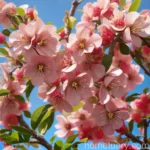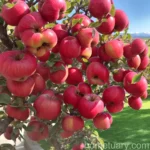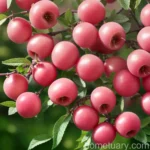Weeping Crabapple (Malus x scheideckeri ‘Red Jade’): A Complete Guide
Introduction
Welcome to the complete guide on the weeping crabapple, specifically the Malus x scheideckeri ‘Red Jade’ variety. We will delve into the culture, uses, care, and maintenance of this stunning ornamental tree. Whether you are a seasoned gardener looking to enhance your landscape or a beginner with a green thumb seeking to learn more about this captivating plant, this guide will equip you with a comprehensive understanding of all aspects associated with the weeping crabapple.
What is Weeping Crabapple?
The Malus x scheideckeri ‘Red Jade’ or weeping crabapple is a cultivar renowned for its elegant weeping habit and captivating ornamental features. It belongs to the family Rosaceae and is a hybrid of crabapple species. Its remarkable beauty makes it a popular choice for ornamental gardens, landscapes, and public parks.
Key Takeaways
Before delving into the specifics of the weeping crabapple, let’s go over the key takeaways:
- Weeping Crabapple Varieties: Explore the diverse range of weeping crabapple varieties and their unique characteristics.
- Weeping Crabapple Tree Care: Understand the essential aspects of caring for a weeping crabapple tree, including water, sunlight, and soil requirements.
- Red Jade Weeping Crabapple: Discover the distinct features and appeal of the Malus x scheideckeri ‘Red Jade’ variety.
- Pruning Techniques: Learn the best practices for pruning weeping crabapple trees to maintain their shape and health.
- Common Diseases and Pests: Identify potential diseases and pests that can affect weeping crabapples and how to address them effectively.
- Growth and Maintenance: Gain insight into the growth rate, maintenance, and seasonal care for weeping crabapple trees.
Culture
Understanding the cultural requirements of the weeping crabapple is crucial to ensuring its optimal growth and stunning visual appeal. Let’s explore the culture associated with this captivating ornamental tree.
Uses
The weeping crabapple, with its graceful drooping branches and vibrant blossoms, serves various purposes in landscaping and horticulture. Its uses include:
- Ornamental Highlight: As a focal point in gardens and landscapes, the weeping crabapple adds an enchanting touch with its cascading form and seasonal blooms.
- Wildlife Attraction: The tree’s blossoms and fruits attract pollinators such as bees and butterflies, adding ecological value to the surrounding environment.
- Aesthetic Appeal: Whether planted as a standalone specimen or incorporated into mixed plantings, the weeping crabapple contributes to a visually appealing and dynamic landscape.
Water
Proper watering is essential for the health and vitality of the weeping crabapple. Here are some key water-related considerations:
- Establishment Phase: During the initial establishment phase, provide regular watering to ensure the tree develops a strong root system.
- Seasonal Watering: Adjust watering frequency based on seasonal conditions, ensuring adequate moisture during hot and dry periods.
- Avoid Waterlogging: While the weeping crabapple appreciates moist soil, it is essential to prevent waterlogging, which can lead to root rot and other issues.
Sunlight
Sunlight plays a pivotal role in the growth and flowering of the weeping crabapple. Consider the following sunlight-related factors:
- Full Sun Exposure: The weeping crabapple thrives in full sun, typically requiring at least 6-8 hours of direct sunlight for optimal growth and abundant blooming.
- Site Selection: When planting the tree, choose a location that receives ample sunlight and offers protection from strong winds, if possible.
- Sunlight Requirements: Understanding the specific sunlight requirements of the Malus x scheideckeri ‘Red Jade’ variety is crucial for its successful cultivation.
Fertilizer
Proper fertilization contributes to the overall health and vigor of the weeping crabapple. Consider the following fertilizer-related guidelines:
- Balanced Fertilizer: Use a balanced, slow-release fertilizer to provide essential nutrients without promoting excessive vegetative growth.
- Timing of Fertilization: Apply fertilizer in early spring before new growth emerges, ensuring that the tree has access to nutrients as it enters the active growing season.
- Avoid Overfertilization: Exercise caution to prevent overfertilization, which can lead to imbalanced growth and potential issues with the tree’s overall health.
Soil
Understanding the soil preferences of the weeping crabapple is essential for creating an optimal growing environment. Let’s delve into the soil-related considerations associated with this stunning ornamental tree.
Soil Preferences
The weeping crabapple thrives in well-draining, slightly acidic soil with the following characteristics:
- Loamy Soil: A well-draining loamy soil provides an ideal growing medium for the weeping crabapple, ensuring proper aeration and moisture retention.
- Soil pH: Aim for a slightly acidic soil with a pH range of 6.0-6.5, which supports nutrient uptake and overall plant health.
- Soil Amendments: Incorporating organic matter into the soil can enhance its structure and fertility, promoting favorable conditions for the weeping crabapple’s root development.
Moisture Management
Effective moisture management is pivotal for maintaining optimal soil conditions and supporting the weeping crabapple’s growth. Consider the following moisture-related aspects:
- Mulching: Apply a layer of organic mulch around the base of the tree to conserve soil moisture, suppress weed growth, and provide insulation against temperature fluctuations.
- Water Retention: Well-draining soil that retains adequate moisture without becoming waterlogged is crucial for the weeping crabapple’s overall health and vitality.
- Drought Tolerance: While the weeping crabapple appreciates consistent moisture, it also exhibits a degree of drought tolerance once established, making it suited for various environmental conditions.
Pruning
Pruning plays a vital role in maintaining the elegance and form of the weeping crabapple while promoting overall tree health. Here are some essential pruning-related considerations.
Pruning Techniques
Proper pruning techniques help shape the weeping crabapple and address any potential issues related to growth and structure. Consider the following pruning techniques:
- Selective Pruning: Focus on selective pruning to remove dead, damaged, or crossing branches while preserving the tree’s natural form and aesthetic appeal.
- Timing of Pruning: Prune the weeping crabapple during the dormant season, typically in late winter to early spring, before new growth begins.
- Caution with Pruning Cuts: Exercise care when making pruning cuts to minimize the risk of disease entry and promote efficient wound healing.
Maintenance Pruning
Regular maintenance pruning contributes to the overall health and visual appeal of the weeping crabapple. Here are some maintenance pruning considerations:
- Removing Suckers: Monitor the base of the tree for suckers and promptly remove them to prevent the establishment of unwanted growth.
- Thinning Branches: Thinning out overcrowded branches can improve light penetration and air circulation within the canopy, reducing the risk of disease and promoting overall tree vigor.
- Structural Integrity: Evaluate the tree’s overall structure and prune to maintain a balanced, symmetrical form while addressing any potential weak or competing branches.
Training Weeping Crabapples
Training weeping crabapple trees involves guiding their growth to achieve a desired form and structure. Consider the following aspects related to training weeping crabapples:
- Stake Support: Providing temporary stake support during the early stages can help establish the desired weeping form and prevent potential damage from strong winds.
- Guided Growth: Gently guide the weeping branches during the tree’s early development to encourage their graceful, cascading form.
- Regular Evaluation: Periodically assess the tree’s growth and adjust training as needed to maintain its picturesque and harmonious appearance within the landscape.
Propagation
Propagating weeping crabapples enables the cultivation of new specimens while preserving the desirable characteristics of specific varieties. Here are some essential aspects related to the propagation of weeping crabapple trees.
Propagation Methods
Several methods can be used to propagate weeping crabapples, including:
- Grafting: Utilize grafting techniques to join the weeping crabapple variety onto a compatible rootstock, ensuring a reliable and consistent replication of the desired traits.
- Air Layering: Employ air layering to encourage the development of roots on a selected branch, subsequently allowing it to be severed and established as an independent tree.
- Cuttings: Take semi-hardwood cuttings from the weeping crabapple and propagate them under favorable conditions to establish new, genetically identical trees.
Timing of Propagation
Selecting the appropriate timing for propagating weeping crabapples is essential for achieving successful outcomes. Consider the following timing-related guidelines:
- Early Spring: The early spring period, before the active growing season, is an ideal time for propagating weeping crabapples through grafting or cutting methods.
- Optimal Conditions: Ensure that propagation efforts align with optimal environmental conditions, including favorable temperatures and adequate moisture for the development of new plants.
- Patience and Care: Exercise patience and care during the propagation process, monitoring the progress of new plants and providing the necessary support for their healthy establishment.
Container Popularity
The weeping crabapple’s popularity as a container plant is attributed to its graceful form, vibrant blossoms, and adaptability to confined growing spaces. Consider the following aspects related to the popularity of weeping crabapples as container plants.
Versatile Container Planting
Planting weeping crabapples in containers offers numerous benefits and opportunities for creative landscaping. Here are some key considerations related to container popularity:
- Limited Space: Suitable for small gardens, urban settings, and patios, container-grown weeping crabapples provide an opportunity to enjoy their ornamental beauty in limited spaces.
- Portability: Container planting allows for easy repositioning and provides flexibility in showcasing the weeping crabapple’s seasonal features throughout the landscape.
- Enhanced Aesthetics: Incorporate container-grown weeping crabapples into various design themes, adding visual interest and dynamic appeal to outdoor living spaces.
Container Selection
Choosing the right containers for weeping crabapples is essential for providing adequate growing conditions and supporting their overall health. Consider the following container selection guidelines:
- Size and Depth: Select containers that offer ample room for root development and stability, allowing the weeping crabapple to thrive without becoming root-bound.
- Drainage: Ensure that containers have sufficient drainage holes to prevent waterlogging and promote proper aeration within the growing medium.
- Material Considerations: Opt for durable, weather-resistant materials such as terracotta, fiberglass, or resin for long-term container planting success.
Common Diseases
Understanding the potential diseases that can affect weeping crabapples is pivotal for implementing proactive management strategies. Here are some common diseases and their associated symptoms.
Apple Scab (Venturia inaequalis)
- Symptoms: Circular, olive-green to black lesions on leaves and fruits, resulting in defoliation and reduced fruit quality.
- Management: Implement preventive fungicidal sprays and maintain good air circulation to minimize disease development.
Fire Blight (Erwinia amylovora)
- Symptoms: Wilting, blackening of blossoms, and cankers on branches, potentially leading to dieback and tree decline.
- Management: Prune out affected branches and avoid excessive nitrogen fertilization to reduce disease susceptibility.
Cedar Apple Rust (Gymnosporangium juniperi-virginianae)
- Symptoms: Orange-yellow spots on leaves and fruits, often accompanied by deformation and premature defoliation.
- Management: Utilize resistant cultivars and minimize the proximity of susceptible hosts to reduce disease pressure.
Powdery Mildew (Podosphaera leucotricha)
- Symptoms: White powdery patches on leaves and shoots, potentially inhibiting photosynthesis and stunting overall tree growth.
- Management: Apply fungicidal sprays and ensure adequate spacing to enhance air circulation and reduce humidity.
Disease Diagnosis
Accurately diagnosing diseases affecting weeping crabapples is crucial for implementing targeted management strategies. Here are some key steps for disease diagnosis.
Visual Assessment
Conduct a visual assessment of the tree, focusing on the following aspects:
- Foliage Symptoms: Examine the leaves for discoloration, spots, deformities, or unusual powdery coatings.
- Blossom and Fruit Inspection: Evaluate the blossoms and fruits for any signs of abnormal growth, lesions, or other visible symptoms.
- Canker Examination: Check for the presence of cankers on branches, noting their location and extent of damage.
Sample Analysis
Collecting and analyzing plant samples can provide valuable insight into the presence and identity of diseases. Consider the following sample analysis techniques:
- Leaf and Fruit Samples: Collect representative leaf and fruit samples displaying symptoms, ensuring that they are properly preserved for laboratory analysis.
- Branch Samples: When cankers or other branch-related symptoms are observed, consider submitting branch samples for detailed examination and disease identification.
- Professional Consultation: Seek assistance from plant pathologists or diagnostic laboratories for accurate disease diagnosis and tailored management recommendations.
Common Pests
Weeping crabapples may face potential pest infestations that can affect their overall health and aesthetic appeal. Here are some common pests associated with weeping crabapples.
Aphids
- Symptoms: Presence of small, soft-bodied insects on new growth, often causing leaf distortion, honeydew secretion, and potential sooty mold development.
- Management: Utilize insecticidal soaps or horticultural oils to control aphid populations and encourage natural predator activity.
Caterpillars
- Symptoms: Defoliation, webbing, and the presence of larvae on leaves and branches, potentially leading to significant damage if left unmanaged.
- Management: Handpick caterpillars when feasible, and employ biological controls such as Bacillus thuringiensis (Bt) for targeted management.
Scale Insects
- Symptoms: Formation of protective scales on branches and stems, often causing chlorosis, weaken branches, and overall decline in tree vigor.
- Management: Implement horticultural oils or insecticidal treatments during the dormant season to target scale insects and limit their impact.
Japanese Beetles
- Symptoms: Feeding damage characterized by skeletonized leaves, defoliation, and the presence of metallic green beetles on the foliage.
- Management: Utilize traps, physical removal, and targeted insecticide applications to reduce Japanese beetle populations and minimize damage.
Botanist’s Tips
As a plant scientist with a passion for weeping crabapples, I am pleased to offer the following botanist’s tips for cultivating and caring for these captivating ornamental trees.
- Seasonal Observation: Regularly observe the weeping crabapple tree throughout the year, noting its appearance, growth patterns, and any changes in its overall health.
- Integrated Pest Management: Embrace integrated pest management principles, emphasizing proactive cultural practices, biological controls, and targeted pesticide use when necessary.
- Soil Health: Prioritize soil health through organic amendments, mulching, and routine soil testing to ensure that the weeping crabapple has access to essential nutrients and favorable growing conditions.
- Consistent Monitoring: Engage in consistent monitoring of the tree’s overall condition, addressing any issues promptly to prevent potential escalation and long-term impact on its health.
- Educational Outreach: Share your passion for weeping crabapples with others, fostering an appreciation for these remarkable trees and the value they bring to landscapes and ecosystems.
Fun Facts
- The weeping crabapple’s blossoms are highly attractive to pollinators, making it a valuable addition to pollinator-friendly gardens and landscapes.
- Weeping crabapple trees can exhibit exceptional autumn foliage colors, ranging from vibrant reds and oranges to rich golden hues, adding seasonal interest to the landscape.
- The weeping form of the crabapple is achieved through selective propagation and cultivation, highlighting the artistry and skill involved in shaping these remarkable trees.
Links to External Resources
For additional insights and resources on weeping crabapples and related topics, consider exploring the following links:
- The American Crabapple: A Profile for Gardeners, by the University of Florida
- Crabapples and Ornamental Trees, by the University of Minnesota Extension
- Pest Management in Home Orchards, by the University of California Agriculture and Natural Resources
Conclusion
In conclusion, the weeping crabapple, particularly the Malus x scheideckeri ‘Red Jade’ variety, is a captivating ornamental tree with a myriad of qualities and features that make it a prized addition to gardens, landscapes, and urban environments. By embracing the insights and guidance offered in this comprehensive guide, you can embark on a rewarding journey of cultivating and caring for weeping crabapples, harnessing their natural beauty and seasonal allure to create enchanting outdoor spaces and vibrant ecosystems. May your exploration of weeping crabapples lead to an enduring appreciation for these remarkable trees and the joy they bring to your horticultural endeavors.















